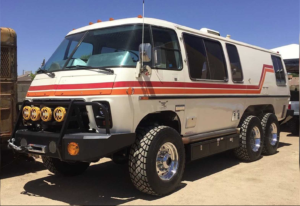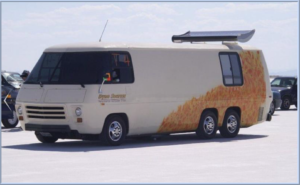GMC Motorhhome Converstion to an Electric Vehicle
Mission Statement:
Ten years ago I purchased a 1973 GMC motorhome for the purpose of traveling North America. The plan was to use the vehicle for several weeks each spring and fall traveling the back roads and staying in state parks, nation parks and the like. At the end of each trip, the vehicle would be left in storage and recovered for the next trip.
Given that the vehicle was already over 30 years old, I thought it best to have the vehicle rebuilt. This became a much more extensive project than anticipated; the result was a spectacular vehicle we could enjoy living in for extended periods.
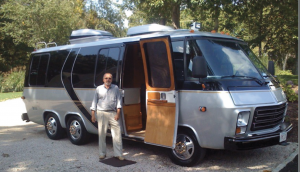
However, after about eight years, the number of technical challenges became a significant negative and we stopped using the vehicle.
Even at it’s best, the fuel consumption at 6-8 miles to the gallon, the noise of a big v-8 and the number of things to go wrong were all limits to our enjoyment. We know that our cost is 10 or more times the market value of the vehicle, so little is gained by selling it. The vehicle has now been mothballed and is in storage.
Just for information, I am not the only crazy GMC owner. Take a look at this 6 wheel drive version. A real off road version.
How about these racing versions out to set the speed record for an RV.
The electric vehicle (EV) revolution lead by Tesla has opened up a new avenue of exploration for the future of this particular coach.
The GMC is unique among the motorhomes as it was not built to sit on top of a truck body. Instead it was built around an automotive drive train (Olds Toronado front wheel drive) and a custom frame with no rear axel. The result is a an underbody that looks like a skateboard and sits very low to the ground. 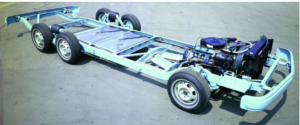
Coincidently, all of the new generation of truck EV builders have adopted the skateboard format ( Rivian, Lordstown, Atlis , etc.)
This is Rivian version, raised in the rear so not a good choice. 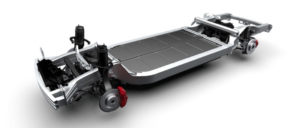
This is the Lordstown platform, better but still not flat.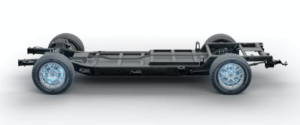
This is the Atlis platform that is to be sold separately. It is flat, offered in any lenght, width, axel, and battery combination. This unit is proposed with ‘in wheel’ drive that your allow a six wheel drive version of the GMC.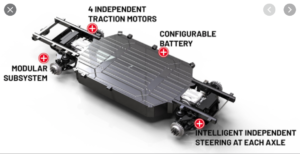
At this hour, only the Tesla is in production. While Tesla does not sell it’s platform separately, there are a sufficient number of wrecked Teslas to supply the necessary components if one wanted to go that route.
Alternatively, there are other battery and power trains coming available such as the Nordic built boats with up to 350kw of battery with 600+hp motors. There is also a whole world of electric trucks and buses that have been developed in China.
While the use of Telsa S sedan components are not a selection at this time, they do offer the basis for analysis while Rivian, Atlis and the Telsa pickup are being developed.
What are the parameter that need to be addressed for GMC-EV?
- 1. Enough horsepower to move a 10,000 pound, maybe more with the batteries, vehicle over the Rockies at 65 mph.
- 2. Based on our 34,000 miles of travels on this vehicle, we need a range of 300 miles.
- 3. The vehicle should be able to recharge overnight, say 12 hours, at locations one would want to spend the night, state parks. Alternatively, it could be supercharged in an hour or so at an on route location.
- 4. The set up must be something more than two people in the world understand, we travel the back roads. Ideally, we would adopt a proven ‘skateboard’ design.
- 5. The conversion cost should be less than six figures.
- 6. The conversion should be completed by Dan’s 80th birthday, four years away. (in 2021 now only two years away).
- Power
This GMC is powered by a 455 ci Rocket V8 that was rebuilt, fuel injected and blueprinted by Technical Services in Indiana. It develops 390 lb-ft and 224 hp @3,200 rpm.
By comparison a Tesla X P100D develops 791 lb-ft and 762 hp (259 hp front, 503 hp rear). The Rivian has over 800 lbs of torque and almost 800 hp delivered to four wheels, the Atlis is expected to be comparable.
Ideally, the GMC EV would have a front motor….about a match for the current internal combustion engine (ICE) on an axel for front wheel drive.
Currently, all of the EV platforms except Atlis have a rear axel, whether they are two or four wheel drive. This rear axel hump is a problem. There are two potential solutions:
a. Make the vehicle front wheel drive only and use the existing rear suspension of the GMC or a similar set up where the rear wheels are attached to the frame.
b Use in-wheel motors on the rear wheels. Currently Protean and Elaphe offer in-wheel motors that could potentially be used for the rear four wheel. Both are making in-wheel motors in the 100ph/wheel range. Having rear motors provides both six wheel drive and regenerative braking from these wheel to improve the range.
At this point, power does not seem to be an issue. The issue would be trying to integrate the rear motors with an existing platform.
2. Range
The GMC came with two 25 gallon fuel tanks, at 6-8 miles/gal this would give a range of 300-400 miles. This GMC was refitted with two tanks with total 80 gallon capacity.
The GMC 23’ weights in at 10,500 lbs, the 26’ is about 12,500 lbs.
Tesla S or X is about 5,000 lbs. With a 100KW battery one of these cars has a range of about 350 miles. The weight of 100kw battery is about 1,000 lbs.
The Rivian and Atlis each weight in at about 5,800 lbs and claim a 400 mile range with a 180kw battery.
Let’s assume that two Telsa 100kw battery modules are required. The 100kw module consists of 16 battery packs (27”x12”x3”) at about 56 lbs each.
This would require an area about 4.5’ x 8’ x 6” with a weight of about 2,000 lbs.
Eighty gallons of fuel is about 600 lbs, the engine weight is about 500 lbs, the transmission, coolers, etc. must add another couple of hundred pounds.
At this point, 200kw would appear to provide enough range and size does not seem to be an issue.
3. Charging
Tesla has by far the most extensive charging network in the world. Let’s assume that we are going to use that network. The network today consists of 433 Super Chargers and 3,267 destination chargers. While Super Chargers would be great, they are mostly urban or on interstates, not our destination.
Focusing on the destination chargers, these are like what you have for your electric stove, a 220v/3 phase 40 amp outlet, a 14-50 plug. This is also a very common plugs for RV’s in state campgrounds. A quick search of campgrounds on Reserve America revealed that about a third of state parks and most private campgrounds had 50 amp 15-50 outlets.
These chargers provide about 22 miles of range/hr of charging for a Tesla, or about 10 miles of range for the proposed GMC set up. This would require about a 20 hr charge for a typical 200 mile day, or a day and half charge for the full range of the vehicle.
If no 14-50 circuit is available, the typical campground 30 amp 110v outlet would provide about 2 miles of range per hour of charge. This would also be true of the on board 5kw generator in this GMC. Clearly, only a backup in dire circumstance.
We tow a Smart car behind the GMC and have driven the Smart about the same miles as the GMC. It is typical for us to park the GMC in a campsite and go off for the day or a couple of days in the Smart using the GMC as a base.
The chart below shows the growth of the Tesla charging network growth from 2013 to 2016. Each year thereafter they doubled the number of charging locations. This does not include campground locations.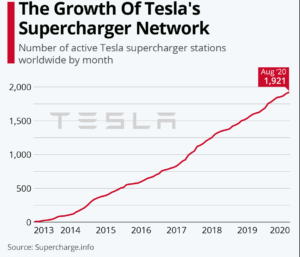
This chart shows only Tesla chargers. Many others are building our private networks and a number of the truck builders are proposing fast chargers at campgrounds.
The range issue presents some limits but is not considered a killer.
4. The Setup
While it would be possible to cobble together some electric motors and batteries, the GMC is already rather rare with less than 10,000 made and an estimated 3,000 still on the road. Creating a cobbled together vehicle with the expectation of using it to explore the country is rejected out of hand.
The quest is going to be finding the right platform that can be modified to the GMC dimension, yet maintain the integrity of the systems. Here is a comparison of dimensions from what I know at this time.
| GMC 23′ | Cybertruck | Rivian S1 | Lordstown | Atlis | |
| Front Track | 75.28 | 79.8 | 67.3 | ||
| Rear Track | 85.12 | 67.3 | |||
| Wheelbase to front | 140 | 149.9 | 135.9 | 135 | 144-176 |
| Wheebase to rear | 160 | ||||
| Overall length | 276 | 231.7 | 217.1 | ||
| Overall Width | 96 | 79.8 | 81.8 | ||
| Overall height | 97 | 75 | 75.7 | ||
| Weight | 10,000 | 6,500 | max | ||
| Wheel size | 16″ | ||||
| Drive type | tri 4 wheel | 4 in wheel | 4-6 in wheel | ||
| Battery size | up to 180kw | 109kw | up to 250 | ||
| HP | 700 | 600 | |||
| Range | 500 | 400 | 250 | 500 | |
Currently, nothing comes very close to matching the track and wheelbase of the GMC; however, it’s better if it be over than under.
Both Lordstown and Atlis are proposing in wheel motors with relatively flat skateboards and therefore are the leading contenders. It should be noted they are also the furthest behind in their development and funding.
My recent interest has focused on Protera, a maker of EV systems for trucks and buses. Their Duo Power electric drivetrain is 550ph with one motor for each wheel, this would maintain the front wheel drive setup. There S serves batteries are 123kw each and can be ganged together. These batteries are 6.89” high and 33.8” wide with various lengths depending on capacity. Alternatively, the H services are each 82 kw with a 24” width.
While all of this might be possible, it sure looks like my goal of 2023 looks like a stretch..
5. Cost
A wrecked Telsa 100 today costs about $15-25,000, a battery pack is about $15,000. Assuming one wants all the components from wheels to dashboard, the rebuilt would include modifications to the interior as well as the running gear. $50,000 for parts and an equal amount for labor…..not impossible.
Thankfully my recent gain on a relatively small amount of Tesla stock can fund this project.
CONCLUSION
This is not a crazy proposition, but it is likely premature and needs a lot of study before any work is committed.

